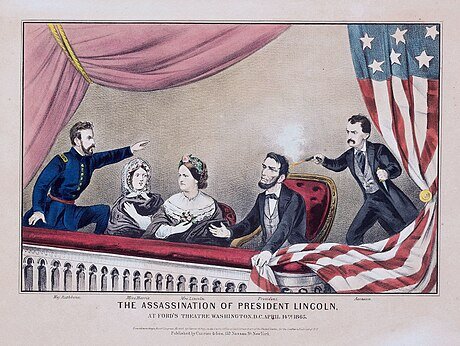HOLY COW! HISTORY: The assassin, automaker and Academy Award-winning actress
Admittedly, it sounds like the start of a joke: “So a presidential assassin, a pioneering automaker and an Academy Award-winning actress walk into a bar…” But it’s not. …
This item is available in full to subscribers.
Subscribe to continue reading. Already a subscriber? Sign in
Get 50% of all subscriptions for a limited time. Subscribe today.
Please log in to continueNeed an account?
|
HOLY COW! HISTORY: The assassin, automaker and Academy Award-winning actress
Admittedly, it sounds like the start of a joke: “So a presidential assassin, a pioneering automaker and an Academy Award-winning actress walk into a bar…” But it’s not.
How can this trifecta of widely disparate characters share anything in common? I’m glad you asked because each holds a piece of the most bizarre historical tale you’ll ever hear.
It all started on Good Friday night in April 1865, when John Wilkes Booth leaped out of the presidential box at Ford’s Theatre and into American history. Captured and killed at the end of a 12-day manhunt, he was quickly interred without the public glimpsing the remains. That was just fine with most Americans, who were more than eager to put the ugliness of Abraham Lincoln’s murder behind them.
But because Booth had been buried in secret, conspiracy theorists sprang into action. Whispers of, “You know, that wasn’t really Booth who was shot in that tobacco barn,” circulated for the next 50 years.
Things were taken to the next level in 1907 when “The Escape and Suicide of John Wilkes Booth” was published.
Its author, Finis L. Bates, was born and raised on an antebellum plantation in Mississippi. Too young for the War Between the States, his family moved to Texas, where he became a lawyer. It was in the Lone Star State that Bates first heard this strange story.
As he later explained in his 309-page book, Bates met a town character in Granbury, Texas, known for reciting long passages of Shakespeare from memory, with The Bard having been Booth’s acting forte. He went by the name, John St. Helen, among others.
While ailing in the late 1870s, St. Helen supposedly told Bates, “My name is John Wilkes Booth, and I am the assassin of President Lincoln… notify my brother (the famous actor), Edwin Booth, of New York City.” St. Helen recovered and later skipped town, never to be seen in Granbury again.
Bates initially thought the story was a bunch of malarky. But the more he pondered it, the more intrigued he became. In 1900, he wrote to the War Department, claiming the $100,000 reward offered in 1865 for Booth’s capture.
He didn’t get it.
Then, in 1903, Bates was reading the newspaper when a photo caught his eye. Though he was now practicing law in Memphis, Tenn., the crazy story he’d heard 25 years earlier still fascinated him. Bates read that a man named David E. George had committed suicide in an Enid, Okla. hotel room and how, following a previous botched suicide attempt nine months earlier, had said, “I am the one who killed the best man who ever lived. I am J. Wilkes Booth.” The report was accompanied by a photo of George’s embalmed body.
Bates recognized the face immediately as that of John St. Helen. Some accounts claim the dying George had summoned Bates. Either way, the lawyer immediately hopped on a train and headed for Oklahoma.
As bizarre as things had been up until then, they quickly turned downright surreal.
When nobody claimed the amply arsenic-embalmed body, the funeral director sat it in a chair in a window, eyes opened and holding a newspaper, as an attention-getter. Some 10,000 people gawked at it over eight years. When the novelty wore off, and with nobody wanting it, the body wound up in the garage at Bates’ Memphis house.
This is where Henry Ford meandered into the story. The early auto giant had stumbled into the quicksand of controversy when he was quoted in a 1916 Chicago newspaper article saying, “History is more or less bunk. It’s tradition. We don’t want tradition. We want to live in today, and the only history that’s worth a tinker's damn is the history we make today.”
In the blink of an eye, the man whose assembly lines were cranking out streams of Model Ts now turned to mass-producing damage control.
In 1919, Ford learned of Bates’ book and realized if he could verify its claim that Booth had escaped, it would vindicate his “history is bunk” statement. So, he set researchers looking into it. He even invited Bates to visit him in Michigan, whereupon Bates offered to sell him George’s corpse. When Ford’s factfinders failed to substantiate most of the book’s allegations, Ford passed on the mummy.
Bates eventually rented it to a showman, who in turn rented it to touring carnivals as a freak show exhibit. At one point, outraged aging Union Civil War veterans threatened to hang the corpse. It bounced around from one increasingly seedy carnival to another and was last seen sometime in the late 1970s.
Bates believed the Booth-St. Helen-George story until the day he died in 1923 at age 75.
He never got to meet his granddaughter, who was born 25 years later, meaning he also never saw the night in March 1991 when Kathy Bates took home the Best Actress Academy Award for her role as the creepy nurse in the hit movie, “Misery.”
Though at last word, no one has questioned her Oscar’s authenticity.
Other items that may interest you










Comments
No comments on this item Please log in to comment by clicking here